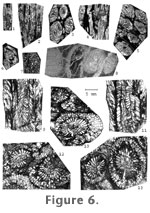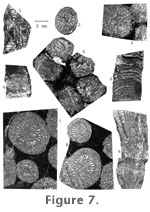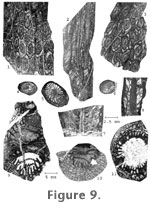|
|
|
SYSTEMATIC PALAEONTOLOGY
All holotypes bear USNM numbers and a C number, and are housed at the U.S. National Museum. Other figured specimens bearing a C number preceded by the letters SJS, presently housed in the San Jose State University Museum of Paleontology, are soon to be transferred to the University of California Museum of Paleontology at Berkeley. Family AULOPHYLLIDAE
Dybowski, 1873
MATERIAL. - Three specimens, five transverse, five longitudinal sections. REMARKS.- The present specimens compare favorably with those figured by Wilson (1982) from the Eastern Klamath terrane. Wilson described the tabulae as "sagging, or sloping inwards and upwards generally to axial tabellae." This is true of his figure 14d, but in his figure 14a the tabulae are more similar to those figured here. As pointed out by Wilson (1982) the present species probably does not belong in the genus Heterocaninia, but at present there are no better options. OCCURRENCE.- SJS 1085, SJS 1088, Bilk Creek terrane. Family LITHOSTROTIONIDAE
d'Orbigny, 1852
MATERIAL. - One colony, two transverse sections. REMARKS.- Material was not available for sectioning longitudinally. This specimen resembles T. captiosa Dobrolyubova, 1936, but it lacks any indication of an axial structure common in that species, it has more septa than generally is present in T. captiosa, and it has better developed minor septa. The present form is very similar to an unnamed species from Lower Permian rocks in Lee Canyon, Spring Mountains, Nevada. OCCURRENCE.- SJS 1294, Central Belt of Northern Sierra Nevada. Family DURHAMINIDAE
Minato and Kato, 1965
MATERIAL. - One colony, three transverse, three longitudinal sections. REMARKS.- This species resembles D. moormanensis in size and number of septa. The present specimen differs in having lonsdaleoid dissepiments locally developed, minor septa that commonly are interrupted, and an axial structure locally with numerous ranks of steeply dipping axial tabellae. Immature corallites 5 mm in diameter show the tangle of major septa at the axis typical of the Durhaminidae. These new specimens, therefore, tend to confirm the assignment of this species to the genus Durhamina. OCCURRENCE.- SJS 897, Bilk Creek terrane. Genus Pseudocystophora
Kossovaya, 1997
DESCRIPTION. - Corallum mostly aphroid, composed of polygonal corallites 14-18 mm in diameter. Wall reduced to few short segments. Major septa 19-20, few to more than one-half extend into axial structure, slightly dilate in tabularium, thin and discontinuous in dissepimentarium; one septum may be slightly shortened. Minor septa extend about 1 mm into tabularium where they are dilated. Axial structure very loose, composed of obscure median lamella, two-three ranks of steeply inclined axial tabellae, and distal parts of up to 13 major septa. Dissepimentarium complex, about one-half corallite radius; outermost dissepiments lonsdaleoid, elongate, narrow, mostly gently dipping, commonly in three or four ranks on both sides of very short wall segments; inner dissepiments of about four ranks, globose, gently to steeply inclined, form a complex of V-shaped, concentric, and lateral dissepiments in transverse section. Tabularium composed of moderately adaxially inclined, complete and incomplete tabulae. ETYMOLOGY. - Named for Edward Wilson who has described most of the corals in the Eastern Klamath terrane. MATERIAL.- One colony, holotype – USNM 531319, 5 transverse, 4 longitudinal sections, Eastern Klamath terrane. REMARKS. - This species resembles P. fryi (Wilson, 1982) in its general characteristics. The present species, however, has considerably larger corallites, more septa, a much more complex dissepimentarium, and much more widely spaced tabulae. OCCURRENCE.- SJS 685, Eastern Klamath terrane. Family KLEOPATRINIDAE
Fedorowski, Bamber, and Stevens, 2007
MATERIAL.- One colony, seven transverse sections. REMARKS.- This specimen is similar to F. major in corallite diameter, number of septa, the relatively long cardinal septum, and the general shortness of minor septa. Material was not adequate for preparation of a longitudinal section. OCCURRENCE. - SJS 1080, Central Belt of Northern Sierra Nevada. Genus Heintzella
Fedorowski, 1967 DESCRIPTION.- Corallum fasciculate, corallites 12-15 mm in diameter. Major septa 24-26, generally thin throughout, several septa commonly much longer than others and extend into axial area; in one corallite cardinal septum very short and counter septum extends to center where it is connected to median lamella. Minor septa very short. Axial structure when present consists of a median lamella commonly connected with counter septum, rarely with one or two septal lamellae. Dissepimentarium one-fourth to one-third corallite radius, composed of about three ranks of steeply dipping globose to elongate dissepiments. Tabularium composed of complete and incomplete tabulae generally slightly arched upward. MATERIAL. - One colony, two transverse, five longitudinal sections. REMARKS.- This specimen resembles the holotype of H. radiata in most respects. It differs in having a narrower dissepimentarium and generally shorter major septa. OCCURRENCE.- SJS 863, Bilk Creek terrane. Genus Paraheritschioides
Sando, 1985 DESCRIPTION.- Corallum fasciculate with corallites 10-17 mm in diameter. Major septa 24-28, thin in dissepimentarium, dilated in tabularium, septa long, several commonly connect with axial lamella; cardinal septum shortened by about 1.5 mm. Minor septa very short, may appear as spines on wall. Axial structure consists of an obscure median lamella, up to 10 septal lamellae, and rarely, few axial tabellae. Dissepimentarium about two-fifths corallite radius, consists of four to six ranks of steeply dipping, globose and elongate dissepiments. Tabularium consists of long, commonly complete, tabulae steeply inclined upward to axial lamella. MATERIAL.- One colony, six transverse, six longitudinal sections. REMARKS.- This specimen is very similar to P. californiense, differing primarily in the extreme shortness of the minor septa and in having much more steeply inclined tabulae. OCCURRENCE.- SJS 1022, block in mélange, most likely derived from the Central Belt of the Northern Sierra Nevada. Paraheritschioides? sp. DESCRIPTION.- Corallum presumed fasciculate, composed of corallites 9-12 mm in diameter. Major septa 18, extend about two-thirds coral radius, cardinal septum shortened about 1 mm, counter septum continuous with median lamella; another septum appears confluent with one septal lamina. Minor septa about one-third length of major septa, slightly penetrate tabularium. Axial structure weak, consists of thin median lamella, one discontinuous rank of axial tabellae, and possibly several septal lamellae. Dissepimentarium about one-fourth corallite radius, consists of two or three ranks of small globose dissepiments. Tabularium consists of slightly warped tabulae, almost horizontal at dissepimentarium, some then slightly depressed before rising moderately steeply to axial structure. MATERIAL.- One colony, two transverse, two longitudinal sections. REMARKS.- The present specimen is placed in the genus Paraheritschioides even though the early growth stages are unknown because of its general characteristics. In addition, it closely resembles an undescribed species of that genus from northeastern Nevada. Presence of septal lamellae cannot be confirmed because of poor preservation. OCCURRENCE. - SJS 833, clast in a Jurassic conglomerate, most likely derived from Central Belt of Northern Sierra Nevada. Family PETALAXIDAE
Fomichev, 1953
DESCRIPTION.- Corallum cerioid, composed of polygonal corallites up to 11 mm in diameter. Major septa 20-24, extend 2-4 mm into tabularium, some reach median lamella, one septum continuous with median lamella. Minor septa commonly long, extend into tabularium. Axial structure composed of thickened median lamella, rarely two, with few septal lamellae. Dissepimentarium one-third to one-half corallite radius, composed of two to five ranks of steeply dipping lonsdaleoid dissepiments. Tabularium composed of moderately concave upward tabulae that descend moderately steeply from dissepimentarium, then rise steeply upward to median lamella to form periaxial cones. In one corallite axial structure composed of two laminae between which there are gently convex upward partitions, about 7 per mm (see Figure 10.6). ETYMOLOGY.- Named for Ted Danner, an expert on Late Paleozoic rocks in British Columbia, who collected the holotype. MATERIAL.- One colony, holotype - USNM 531318, five transverse, two longitudinal sections, Harper Ranch subterrane of the Quesnel terrane. REMARKS. - This species differs from all other Permian species of the genus in the large size of the corallites, the large number of septa, and the multiple ranks of dissepiments. OCCURRENCE. - SJS 1015, Quesnel terrane. Genus Petalaxis
Milne-Edwards and Haime, 1852 DESCRIPTION.- Corallum cerioid, composed of corallites 5-8 mm in diameter. Major septa 17-18, commonly approach axis, one continuous with median lamella. Minor septa may appear as spines penetrating tabularium. Axial structure composed of one lenticular median lamella. Dissepimentarium generally composed of one rank of steeply dipping lonsdaleoid dissepiments. Tabularium composed of concave upward variably spaced tabulae. MATERIAL.- One colony, seven transverse, four longitudinal sections. REMARKS.- The present specimen resembles the type of P. besti quite closely, differing only in smaller average corallite diameter and generally larger lonsdaleoid dissepiments. OCCURRENCE. - SJS 1014, Harper Ranch subterrane of Quesnel terrane. Petalaxis occidentalis (Merriam, 1942) DESCRIPTION.- Corallum cerioid, composed of corallites 4-5 mm in diameter. Major septa 17-19, of moderate length, one septum continuous with median lamella. Minor septa commonly penetrate tabularium. Axial structure consists of elongate median lamella. Dissepimentarium with one or two ranks of steeply dipping lonsdaleoid dissepiments. Tabularium consists of very steeply dipping tabulae that flatten out or rise slightly to median lamella. MATERIAL. - One colony, two transverse, one longitudinal section. DISCUSSION. - The characteristics of this specimen correspond in all respects to the types of P. occidentalis. OCCURRENCE. - SJS 1045, Central Belt of Northern Sierra Nevada. Genus Lytvophyllum
Dobrolyubova, 1941 (in Soshkina et al. 1941) DESCRIPTION.- Corallum fasciculate, composed of cylindrical corallites 4-5 mm in diameter. Major septa generally about 17, rarely up to 22, moderately long, one septum continuous with median lamella. Nature of minor septa uncertain because of poor preservation. Axial lamella rounded, as much as 1 mm in diameter. Dissepimentarium consists of one to three ranks of elongate, steeply dipping, largely lonsdaleoid dissepiments. Tabulae somewhat concave upward. MATERIAL. - One colony, eight transverse, 13 longitudinal sections. REMARKS.- This species resembles L.? sustutense Fedorowski, Bamber, and Stevens 2007 in number of septa and broad dilation of the median lamella. It differs in the presence of up to three ranks of steeply dipping, elongate dissepiments. OCCURRENCE.- SJS 1032, Central Belt of Northern Sierra Nevada. Lytvophyllum? sp. 2 DESCRIPTION. - Corallum fasciculate with corallites 5-6 mm in diameter. Major septa 18, most extend into axial region, straight to quite irregular, one septum connected to median lamella. Minor septa generally very short, may be reduced to small prongs on wall. Median lamella generally very slightly dilated, rarely rounded. Dissepimentarium impersistent, very narrow, may consist of one rank of steeply dipping, rarely lonsdaleoid dissepiments. Tabularium consists of very steeply declining tabulae. MATERIAL. - One colony, three transverse, one longitudinal section. REMARKS.- This species differs from all other species questionably assigned to the genus Lytvophyllum in that the axial lamella is not consistently dilated (however, note corallite in lower part of Figure 5.1 and the one in the upper part of Figure 5.3), distal portions of major septa may be highly irregular, and tabulae dip very steeply downward to the axial lamella. OCCURRENCE. - SJS 1066, Bilk Creek terrane. Family GEYEROPHYLLIDAE
Minato, 1955 DESCRIPTION.- Nature of corallum uncertain, loosely fasciculate, or solitary. Wall greatly thickened with stereoplasm. Major septa 20-27, rather long, one septum connected to median lamella. Minor septa very short in young corallites, extend as prongs into tabularium in mature specimens. Axial structure composed of a median lamella 1.5 mm in diameter, rounded but irregular because of projections of numerous septal lamellae. In longitudinal section axial lamella appears composed of very fine, sharply domed laminae (Figure 9.8). Dissepimentarium sporadically developed, lonsdaleoid dissepiments rare. Tabularium generally composed of steeply dipping, irregularly disposed tabulae that intersect axial structure horizontally or in some cases rise steeply to become part of it. MATERIAL.- One colony?, six transverse, four longitudinal sections. REMARKS.- The present specimens resemble Darwasophyllum in several respects, but lack the numerous lonsdaleoid dissepiments of that genus. Corallites are numerous in the present sample, but it is uncertain whether or not the corallum is fasciculate. This species probably belongs to a heretofore undescribed genus related to the genus Darwasophyllum. OCCURRENCE. - SJS 1034, Eastern Klamath terrane. |
|





